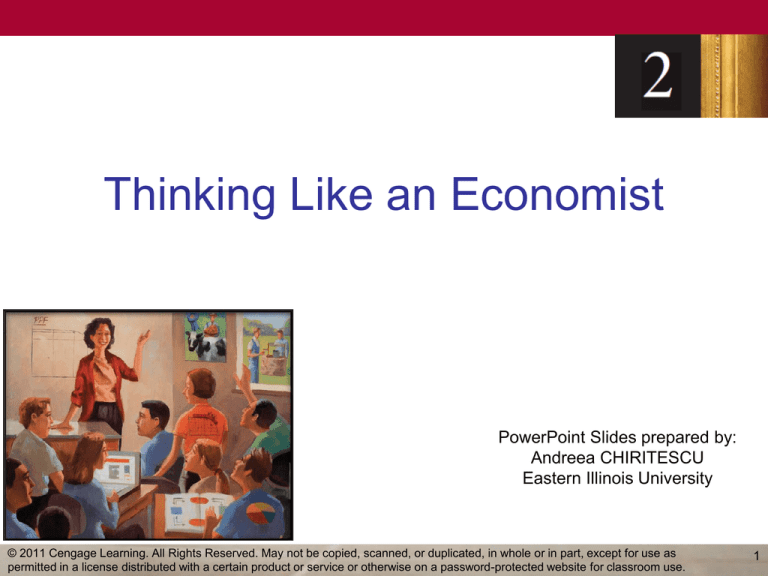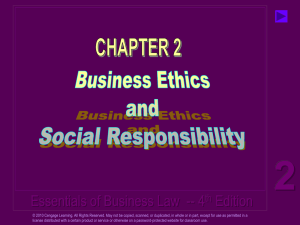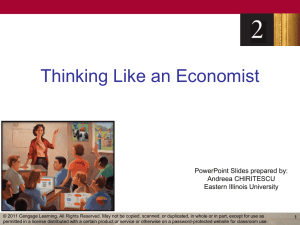
Thinking Like an Economist
PowerPoint Slides prepared by:
Andreea CHIRITESCU
Eastern Illinois University
© 2011 Cengage Learning. All Rights Reserved. May not be copied, scanned, or duplicated, in whole or in part, except for use as
permitted in a license distributed with a certain product or service or otherwise on a password-protected website for classroom use.
1
Reminder: Quiz 1
• Quiz 1 (September 27th,Next Saturday)
• Quiz 1 covers Chapters 1 and 2
• There will be multiple choice questions
and short-answer questions.
Overview
• The scientific method for Economist (how
economics faculties do their research)
• Example of Natural experiment
• The circular-flow model
• Production Possibility Frontier(PPF)
• Examples of Microeconomics,
Macroeconomics and econometrics
• Positive analysis Vs Normative analysis
The Economist as a Scientist
• Economics
– (Social) Science
• Economists
– Scientists
• Devise theories (Hypothesis, Micro or Macro)
• Collect data (Empirical test)
• Analyze these data (Econometrics)
– Verify or refute their theories
© 2011 Cengage Learning. All Rights Reserved. May not be copied, scanned, or duplicated, in whole or in part, except for use as
permitted in a license distributed with a certain product or service or otherwise on a password-protected website for classroom use.
4
The Economist as a Scientist
• Scientific method
– Dispassionate (不带偏见的) development
and testing of theories about how the
world works
– Observation, theory, and more observation
• Conducting experiments
– Difficult / impossible
• Observation (data)
– Close attention to natural experiments
© 2011 Cengage Learning. All Rights Reserved. May not be copied, scanned, or duplicated, in whole or in part, except for use as
permitted in a license distributed with a certain product or service or otherwise on a password-protected website for classroom use.
5
Example
• Observation, theory or model, back to
observation (data)
• An economist experiencing increasing
price (Inflation)
• He proposed a theory: inflation arises
when government print too much money
• collect data on price and money from
different countries
• If price and money are strongly
correlated, he should be more confident
in the theory.
Example 2
• A higher education level, a higher wage
level (observation)
• Hypothesis: higher education will lead to
higher wage. (education is the cause)
• We are more interested in the return to
education!!!
• Data: census, a strong correlation
between wage and education
• We can conclude that the return to
education is positive.
• Is it the end of the story?
Example 2 continued
• No! Selection bias could happen! (people
with higher ability would select to stay in
school longer, they can earn a higher
wage because of their high ability and/or
schooling)
• We want to eliminate selection bias.
• Solutions? Natural experiment
• Angrist and Krueger (1991): compulsory
schooling laws+ difference in date of birth
compulsory schooling laws
• Compulsory schooling laws require
students to enter school in the calendar
year in which they turn 6
• Children born in late months of the year
will enter school at an earlier age
• Compulsory schooling laws requires
children to stay in school until 16
• At the age of 16, those students would be
in different grades.
Example 2 continued
• Date of birth is random, not correlated to ability
• Date of birth + compulsory schooling laws: a
natural experiment in which children are compelled
to attend school for different length of time
• devide observations into groups based on dates of
birth(of course, with variation in education). Then
compare the difference in wage level across
groups.
• There should be no significant difference of ability
for each group.Then, difference in wage should
only be attributed to difference in education.
The Economist as a Scientist
• Economic models
– Diagrams & equations
– Omit many details
– Allow us to see what’s truly important
– Built with assumptions
– Simplify reality to improve our
understanding of it
© 2011 Cengage Learning. All Rights Reserved. May not be copied, scanned, or duplicated, in whole or in part, except for use as
permitted in a license distributed with a certain product or service or otherwise on a password-protected website for classroom use.
11
The Economist as a Scientist
The role of assumptions
• Assumptions
– Can simplify the complex world
• Make it easier to understand
– Focus our thinking - essence of the
problem
– Example (international trade, only two
countries and two goods)
• Different assumptions
– To answer different questions
– Short-run or long-run effects
© 2011 Cengage Learning. All Rights Reserved. May not be copied, scanned, or duplicated, in whole or in part, except for use as
permitted in a license distributed with a certain product or service or otherwise on a password-protected website for classroom use.
12
The Economist as a Scientist
• Circular-flow diagram
– Visual model of the economy
– Shows how dollars flow through markets
among households and firms
• Decision makers
– Firms & Households
• Markets
– For goods and services (Ipad, laptop,cars)
– For factors of production (labor market)
© 2011 Cengage Learning. All Rights Reserved. May not be copied, scanned, or duplicated, in whole or in part, except for use as
permitted in a license distributed with a certain product or service or otherwise on a password-protected website for classroom use.
13
More on Factor of production
• Firm use labor, land, and capital to
produce goods and service
• labor (including knowledge and skill)
• land (not only land, but other natural
resource)
• capital (only refers to buildings, machines,
not financial capital)
• labor market( for example, the job market
for university graduates or phds)
The Economist as a Scientist
• Firms
– Produce goods and services
– Use factors of production / inputs
• Households
– Own factors of production
– Consume goods and services
• No international trade, No government
© 2011 Cengage Learning. All Rights Reserved. May not be copied, scanned, or duplicated, in whole or in part, except for use as
permitted in a license distributed with a certain product or service or otherwise on a password-protected website for classroom use.
15
The Economist as a Scientist
• Markets for goods and services
– Firms – sellers
– Households – buyers
• Markets for inputs
– Firms – buyers
– Households - sellers
© 2011 Cengage Learning. All Rights Reserved. May not be copied, scanned, or duplicated, in whole or in part, except for use as
permitted in a license distributed with a certain product or service or otherwise on a password-protected website for classroom use.
16
Figure 1
The circular flow
This diagram is a
schematic representation of
the organization of the
economy. Decisions are
made by households and
firms. Households and
firms interact in the markets
for goods and services
(where households are
buyers and firms are
sellers) and in the markets
for the factors of production
(where firms are buyers
and households are
sellers). The outer set of
arrows shows the flow of
dollars, and the inner set of
arrows shows the
corresponding flow of
inputs and outputs.
© 2011 Cengage Learning. All Rights Reserved. May not be copied, scanned, or duplicated, in whole or in part, except for use as
permitted in a license distributed with a certain product or service or otherwise on a password-protected website for classroom use.
17
The Economist as a Scientist
• Production possibilities frontier
– A graph
– Combinations of output that the economy
can possibly produce
– Given the available
• Factors of production (fixed)
• Production technology (fixed)
© 2011 Cengage Learning. All Rights Reserved. May not be copied, scanned, or duplicated, in whole or in part, except for use as
permitted in a license distributed with a certain product or service or otherwise on a password-protected website for classroom use.
18
Figure 2
The production possibilities frontier
Quantity of
Computers
Produced
C
F
3,000
A
2,200
2,000
B
Production
Possibilities
Frontier
D
1,000
E
0
300
600 700
The production
possibilities frontier
shows the combinations
of output—in this case,
cars and computers—
that the economy can
possibly produce. The
economy can produce
any combination on or
inside the frontier. Points
outside the frontier are
not feasible given the
economy’s resources.
1,000 Quantity of
Cars Produced
© 2011 Cengage Learning. All Rights Reserved. May not be copied, scanned, or duplicated, in whole or in part, except for use as
permitted in a license distributed with a certain product or service or otherwise on a password-protected website for classroom use.
19
The Economist as a Scientist
• Efficient levels of production
– The economy is getting all it can
• From the scarce resources available
– Points on the production possibilities
frontier
– Trade-off:
• The only way to produce more of one good
• Is to produce less of the other good
© 2011 Cengage Learning. All Rights Reserved. May not be copied, scanned, or duplicated, in whole or in part, except for use as
permitted in a license distributed with a certain product or service or otherwise on a password-protected website for classroom use.
20
The Economist as a Scientist
• Inefficient levels of production
– Points inside production possibilities
frontier
• Opportunity cost of producing one good
– Give up producing the other good
– Slope of the production possibilities
frontier
© 2011 Cengage Learning. All Rights Reserved. May not be copied, scanned, or duplicated, in whole or in part, except for use as
permitted in a license distributed with a certain product or service or otherwise on a password-protected website for classroom use.
21
The Economist as a Scientist
• Bowed out production possibilities frontier
– Opportunity cost of a car – highest
• Economy - producing many cars and fewer
computers (E, use most of its resource to
produce cars)
– Opportunity cost of a car – lower
• Economy - producing fewer cars and many
computers (point F, use most of its resource
to produce computers)
– Resource specialization
© 2011 Cengage Learning. All Rights Reserved. May not be copied, scanned, or duplicated, in whole or in part, except for use as
permitted in a license distributed with a certain product or service or otherwise on a password-protected website for classroom use.
22
The Economist as a Scientist
• Technological advance
– Outward shift of the production possibilities
frontier
– Economic growth
– Produce more of both goods
© 2011 Cengage Learning. All Rights Reserved. May not be copied, scanned, or duplicated, in whole or in part, except for use as
permitted in a license distributed with a certain product or service or otherwise on a password-protected website for classroom use.
23
Figure 3
A shift in the production possibilities frontier
Quantity of
Computers
Produced
4,000
3,000
G
2,300
2,200
A
0
600 650
A technological advance
in the computer industry
enables the economy to
produce more computers
for any given number of
cars. As a result, the
production possibilities
frontier shifts outward. If
the economy moves
from point A to point G,
then the production of
both cars and computers
increases.
1,000 Quantity of
Cars Produced
© 2011 Cengage Learning. All Rights Reserved. May not be copied, scanned, or duplicated, in whole or in part, except for use as
permitted in a license distributed with a certain product or service or otherwise on a password-protected website for classroom use.
24
The Economist as a Scientist
• Microeconomics
– The study of how households and firms
make decisions (choices)
– And how they interact in markets
• Macroeconomics
- The study of economy-wide phenomena,
including inflation, unemployment, and
economic growth
• Econometrics
Statistical method in economics
© 2011 Cengage Learning. All Rights Reserved. May not be copied, scanned, or duplicated, in whole or in part, except for use as
permitted in a license distributed with a certain product or service or otherwise on a password-protected website for classroom use.
25
Examples
• Micro: the impact of foreign competition o
auto industry; The relationship between
wage and education
• Macro: the effect of a federal income tax
cut on the overall production of good and
services; or whether Obama's stimulus
package could increase employment
• Econometrics: peer effect: (the influence
of your friend's behavior on your
behavior)
The Economist as a Policy Adviser
Positive vs. Normative analysis
• Positive statements (a fact)
– Attempt to describe the world as it is
– Descriptive
– Confirm or refute by examining evidence
• Normative statements(with judgement)
– Attempt to prescribe (指定) how the world
should be
– Prescriptive
© 2011 Cengage Learning. All Rights Reserved. May not be copied, scanned, or duplicated, in whole or in part, except for use as
permitted in a license distributed with a certain product or service or otherwise on a password-protected website for classroom use.
27
Examples:
• Positive analysis
Minimum wage laws cause unemployment
Right to work laws will increase
manufacturing employment.
• Normative analysis
The government should raise the minimum
wage.
The government should enforce right to
work laws.







